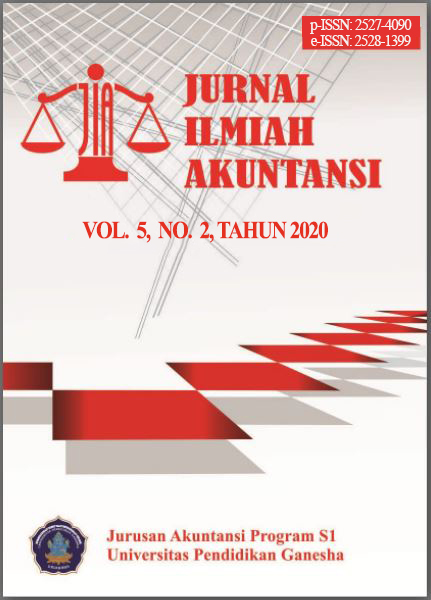Perilaku Kecurangan Akademik Mahasiswa Akuntansi: Dimensi Fraud Diamond
DOI:
https://doi.org/10.23887/jia.v5i2.25949Keywords:
academic cheating behavior, accounting students, fraud diamondAbstract
Academic cheating behavior is the seeds of bigger cheating practices in the future because it can cause more serious problems, such as violations of professional ethics or the occurrence of crimes. This study aims to analyze the influence of fraud risk factors based on the Fraud Diamond perspective, namely pressure, opportunity, rationalization, and competence on the accounting student academic fraud behavior. Data were collected using a questionnaire on 385 accounting students at universities in Bali Province. The data analysis technique used in this research is descriptive statistical analysis and hypothesis testing using multiple linear regression analysis. The results of the study provide evidence that the factors of pressure, opportunity, rationalization, and ability have a positive effect on academic fraud behavior in accounting students.
References
Albrecht, W. Steve, Chad O. Albrecht, Coan C. Albrecht, and Mark F. Zimbelman. 2012. Fraud Examination. Mason, USA: South Western, Cengange Learning.
Aulia, Nadia Rera. 2016. “Analisis Perilaku Kecurangan Akademik Pada Mahasiswa Akuntansi Dengan Menggunakan Konsep Fraud Diamond Dan Religiusitas.” . Yogyakarta: Fakultas Ekonomi Universitas Islam Indonesia.
Becker, J.Coonoly, Paula L, and J. Morriso. 2006. “Using the Business Fraud Triangle to Predict Academic Dishonesty Among Business Students.” Academy of Educational Leadership Journal 10(1):37.
Cizex, Gregory C. 2010. Cheating On Test: How to Do It, Detect It, and Prevent It. New Jersey: Lawrence Erlbaum Associates Inc. Publicher.
Depdiknas. 2008. Kamus Besar Bahasa Indonesia. 4th ed. Jakarta: Gramedia Pustaka Utama.
Eckstein, Max A. 2013. “Combating Academic Fraud-Towards A Culture of Integrity. International Institute for Educational Planning.”
Ghozali, Imam. 2008. Aplikasi Analisis Multivariate Dengan Program SPSS. Semarang: Badan Penerbit Universitas Diponegoro.
Murdiansyah, I., Sudarma, M., &. Nurkholis. 2017. “Pengaruh Dimensi Fraud Diamond Terhadap Perilaku Kecurangan Akademik (Studi Empiris Pada Mahasiswa Magister Akuntansi Universitas Brawijaya).” Jurnal Akuntansi Aktual 4(2):121–33.
Nursani, R., & Irianto, G. 2012. “Perilaku Kecurangan Akademik Mahasiswa : Dimensi Fraud Diamond.” Jurnal Akuntansi Multiparadigma 3(2):161–331.
Purnamasari, Dian dan Gugus Irianto. 2014. “Analisis Pengaruh Dimensi Fraud Triangle Terhadap Perilaku Kecurangan Akademik Mahasiswa Pada Saat Ujian Dan Metode Pencegahannya.” Jurnal Ilmiah Mahasiswa FEB.
Santoso, Muhamad Hadi dan Helmy Adam. 2014. “Analisis Perilaku Kecurangan Akademik Pada Mahasiswa Akuntansi Dengan Menggunakan Konsep Fraud Triangle (Studi Pada Mahasiswa S1 Akuntansi Kota Malang.” Jurnal Ilmiah Mahasiswa FEB.
Sindonews.com. 2017. “Mencegah Plagiasi Di Kampus.”
Steinbart, Romney and. 2012. Accounting Information Systems: Global Edition Twelfth Edition. United States of America: British Library Cataloguing.
Sugiyono. 2011. Metode Penelitian Kuantitatif, Kualitatif Dan R&D. Bandung: Afabeta.
Wolfe, D. T., & Hermanson, D. R. 2004. “The Fraud Diamond: Considering the Four Elements of Fraud.” CPA Journal 74(12):38–42.
Downloads
Published
Issue
Section
License
JIA (Jurnal Ilmiah Akuntansi) is licensed under a Creative Commons Attribution-ShareAlike 4.0 International License
Authors who publish with this journal agree to the following terms:
- Authors retain copyright and grant the journal right of first publication with the work simultaneously licensed under a Creative Commons Attribution Attribution-NonCommercial-NoDerivatives 4.0 International License that allows others to share the work with an acknowledgment of the work's authorship and initial publication in this journal.
- Authors are able to enter into separate, additional contractual arrangements for the non-exclusive distribution of the journal's published version of the work (e.g., post it to an institutional repository or publish it in a book), with an acknowledgment of its initial publication in this journal.
- Authors are permitted and encouraged to post their work online (e.g., in institutional repositories or on their website) before and during the submission process, as it can lead to productive exchanges and earlier and greater citation of published work (See The Effect of Open Access).




1.png)



